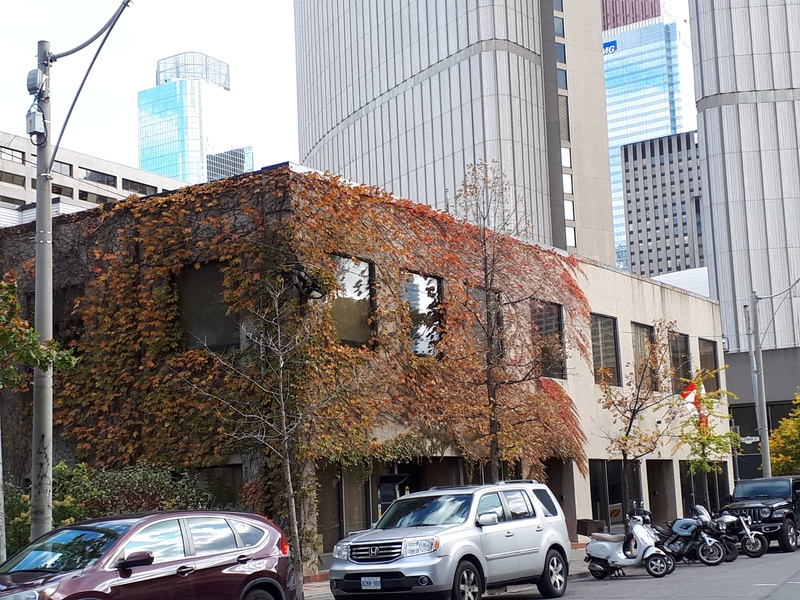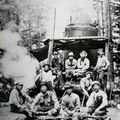The Toronto Buddhist Church started life at 134 Huron Street, in the heart of J-Town, when the Buddhist Church committee purchased a row house for the Rev. Kenryu Tsuji and his wife. Rev. Tsuji sailed on the last boat out of Japan for Canada at the outbreak of WWII after he was ordained a Buddhist minister. He in fact was the first Canadian Nisei to become a minister and later became the Bishop for the Buddhist Churches of America.
I wasn’t even born when the church opened, but I was told it was a lively place with meetings, Dharma talks and services in the living room. Meals prepared by Sakaye Tsuji and the Issei and older Nisei women were served in the dining room. I’m sure it was a chaotic but grand old time.
Larger services such as funerals and weddings were held at the Legion Hall at 245 College Street near Yonge St., close enough to the J-Town area. The Bussei (youth group) held social events like dances at the Legion Hall, Odd Fellows Hall, or Hagerman Hall (behind today's City Hall), all in the area. The Nisei Club formed and organized social events and outings. I donated the only newsletter I could find in the house to the East Asian Library at the University of Toronto, but I remember some of the editorial: “Hey there guys and gals, it’s Sadie Hawkins Day soon. Gals, wear your best duds and grab your favourite guy and swing to the music of Glenn Miller, Benny Goodman and a host of others at Hagerman Hall come Saturday night.” Must’ve been fun.
The Buddhist Church committees founded the Japanese Language Schools since the Issei parents wanted their children and grandchildren to maintain the mother language and to learn the traditions and customs of Japan. Shinkuro Kozai, a former teacher of the Vancouver Language School on Alexander Street, became the principal of the twice-a-week school at the Legion Hall and later at Orde Public School on McCaul Street (maintaining the tie to J-Town).
The church also established the Continental Family Co-operative Store at 618 Dundas St. West (at Huron) to provide families with Japanese staples like rice and tofu. It later privatized to become the Furuya Japanese Food store (mentioned last month).
After much fundraising, the church opened a striking and beautiful building at 918 Bathurst St. north of Bloor Street, just north of the J-Town area.
Other than grocery stores, many other Nikkei businesses started and flourished. The Matsuba family opened a dry-cleaning business in the area and later bought into a franchise called Danforth Cleaners and moved it to the west end. Gertrude Urabe took over her husband’s insurance business when he passed. Her clients were mostly Nikkei. As enterprising as she was, she opened Paramount Gifts which stocked Japanese gifts. She later opened a Japanese restaurant at Eaton’s College St. at Yonge. She sponsored a Sansei hockey team; the league playing every weekend at George Bell Arena in the west end.
The Kawasakis owned a confectionary store at the corner of Huron and Sullivan Streets. Mr. Kawasaki always gave me a dirty look when his son told me to take any bag of chips or candy from the shelves for free. I felt guilty but I took it anyway. Most noteworthy was the fact that, I believe, they were the last family to move out of the area. Just west of the store along Sullivan near Spadina Ave., the Kameoka family ran a Japanese bookstore out of their house. No English books but the clientele were Japanese anyway.
The largest business was Nu Mode Dress. As its name implies, it was a dress factory churning out dozens of garments for the bargain stores throughout the city. It was Jewish owned but managed by a Nisei man, Roy Shin. He hired a multitude of Nikkei, mostly Nisei. They were designers, cutters, seamstresses, and warehouse men. Once a year, Mr. Shin, a designer and eventually his son Mike would go to New York to see the new lines of clothing. They would make note of the trends and sketch the styles. Back to Toronto to copy the patterns for manufacture. Apparently, it was all above board and legal. In any case, they worked hard, five and a half days a week. Mr. Shin barely took time off for a vacation. During an extended family trip to Japan and beyond, Mr. Shin left after a week to get back to work. He was that dedicated.
At the time, a thriving Japanese Canadian community existed in a well-defined part of Toronto. Dr. Kuwabara was everyone’s family doctor, Dr. Nakashima the dentist, and kenjinkai or provincial clubs flourished for the Issei to keep them in touch with kindred spirits and news from back home.
Today, the clubs sponsor annual picnics in provincial parks just outside the city. The Issei even set up tanomoshi (a rotating savings and credit association within kenjinkai or among old friends since trust was an essential component) in order to save money for expensive items like a down-payment for a house or car. Once a month the group would get together to set aside a certain amount of money (my parents invested $100 at a time). Then someone in turn would claim the total (whether they needed it or not) with a promise to pay back the money with interest. In this way, Mrs. Mori (the Kawasaki matriarch) managed to buy seven houses as investment. The Issei was such an industrious generation.
Next month, I’ll end my look at Toronto’s old J-Town by discussing the community newspapers and the role the nearby Chinatown played.
© 2020 Terry Watada






